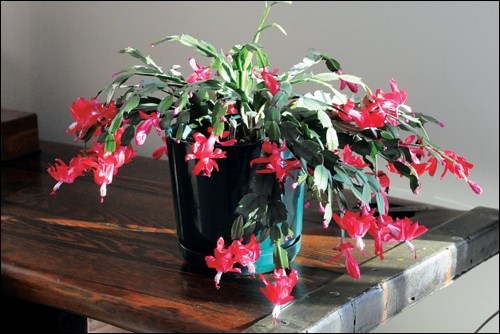It’s all about the timing: the Christmas (Schlumbergera bridgesii and S. x buckleyi), Thanksgiving (S. truncata) and Easter (Rhipsalis gaertneri) cacti may look similar, but the easiest way to tell them apart is to wait until they flower. Their common name says it all: flowering is according to the season.
These three cacti (and others) originate from the tropical forests of Central and South America and differ from their desert cousins in a number of ways that impact their care. First, they are not drought tolerant – keep the soil moderately moist but never wet. Water when the top two or three centimetres of the media is dry to the touch. Second, tropical cacti grow best in bright but filtered light. In winter, direct sun is fine. But in the height of summer, keep them away from intense light. Third, they are not heat tolerant, preferring cooler temperatures. Room temperature is fine except just before and during flowering when lower night time temperatures are best: 12 – 18 C is ideal. Finally, tropical cacti prefer higher daytime humidity than what may be found in a desert environment – around 55 per cent relative humidity.
Christmas cacti can tolerate being pot-bound. However, if your plant is drying out and wilting often, it is time to re-pot into a larger container. Choose a container with a diameter two to three centimetres larger and use a well-drained soil-less potting mix. Like all houseplants, besides correct water, humidity, temperature and light, cacti require nutrients. But because they are relatively slow growing plants, they do not require the same amount or frequency. An all-purpose fertilizer, either water-soluble or controlled release, will do the trick but apply at half strength according to label instructions.
When you first bring a Christmas cactus into you home, it is likely flowering. Flower colours include white, pink, red, salmon and purple. To prolong blooming, put it in a bright location with cool (12 – 18 C) night-time temperatures away from warm (furnace vent) or cold drafts (window or door). Temperatures too high or too low will cause buds and flowers to fall off. Low humidity, a common Saskatchewan winter problem, may also result in flower buds and flowers falling off prematurely. Raising the humidity in the vicinity of your cactus can be as simple as having an open container of water nearby or placing the pot on a tray filled with pebbles but only half-filled water to prevent the soil from becoming saturated. Misting only temporarily raises the humidity unless it is repeated continuously throughout the day and night. Another cause of bud and flower drop is incorrect soil moisture – too dry or too wet.
After the season is over, Christmas cacti are rather non-descript. Fortunately, they are relatively easy to bring back into bloom at the right time of year. The main factor is the length of the night period. For Christmas cacti, flowering is triggered by six to eight weeks of 12-hour nights. In early November, put your Christmas cactus in a room where it will receive little to no artificial light after nightfall. Keep it there until the buds begin to open. If you change the light conditions too rapidly, the buds may fall off before opening. You may notice that only the side exposed to natural light (side facing a window) produces buds, especially in a room with artificial light on at night. Wait until the buds begin to open before turning the plant. Cool temperatures also induce flowering. Commercial growers grow their cacti at 10-13 C starting in early November to guarantee December blooming regardless of day length. However, this may not be practical in most homes.
If you do everything right, you may be rewarded by a second blooming, albeit less vigorous, in early March.




